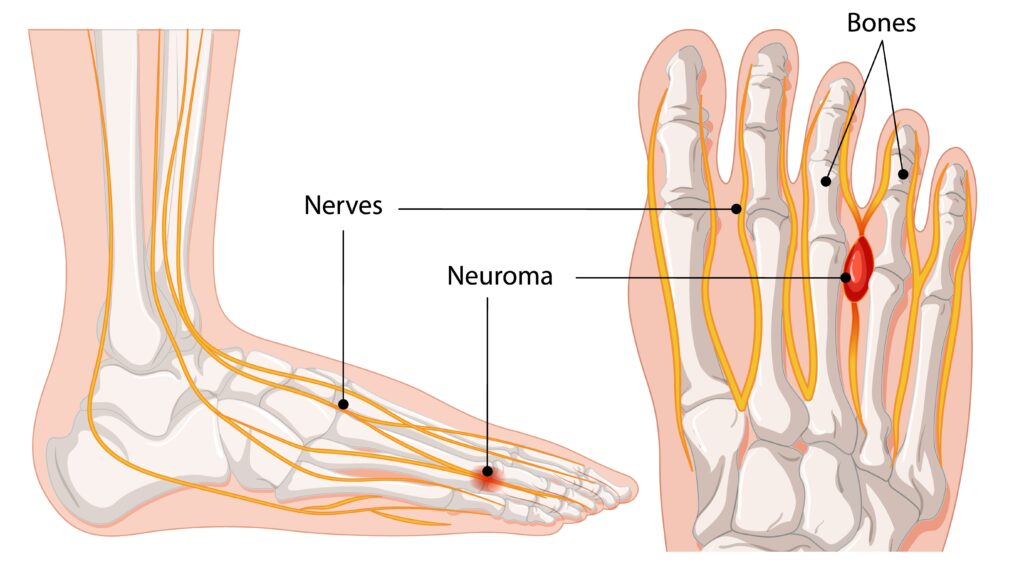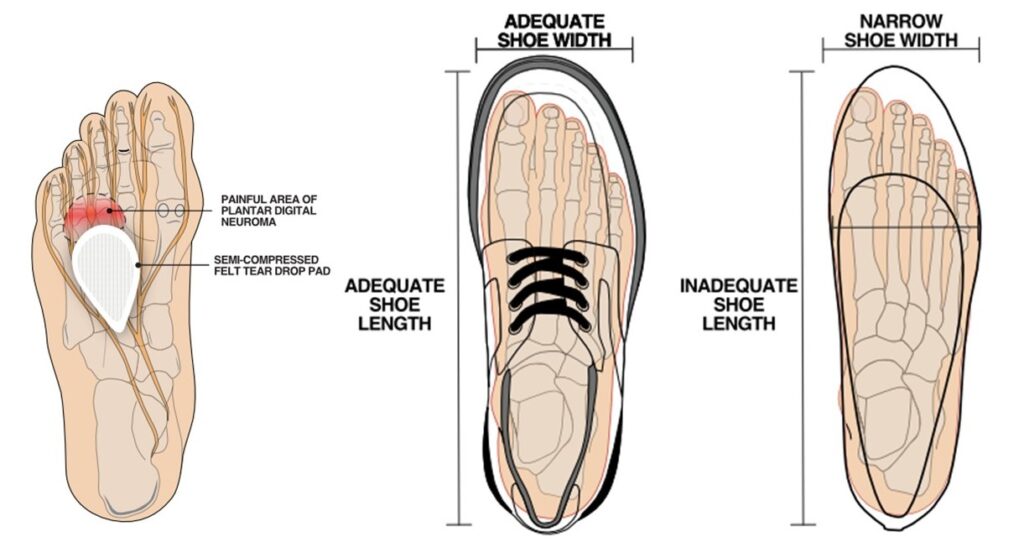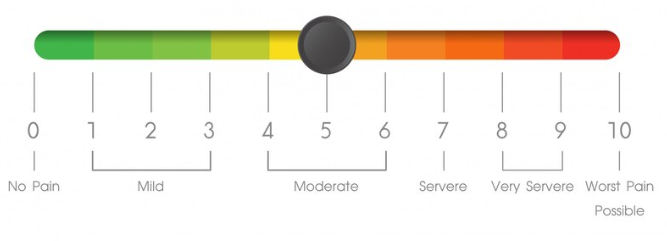Pain in your toe or the ball of your foot – Morton’s neuroma
Pain in your toe or the ball of your foot – Morton’s neuroma
What is Morton’s (Plantar Digital) neuroma?
Morton’s neuroma (also known as plantar digital neuroma) is a thickening of tissue around a nerve in your foot that’s been irritated or damaged, triggering pain and numbness.
People between the ages of 35 and 60 are more prone to developing this condition but it can happen at any age, affecting women more than men. Treatment for Morton’s neuroma usually begins with self-care.

Signs and symptoms of Morton’s neuroma
Pain usually starts in the ball of the foot and can spread into your toes. Burning, tingling or numbness between the affected toes may also be felt. Some people describe the pain like they are walking on a pebble or have a lump on their foot. Symptoms will be aggravated when wearing tight fitting footwear. Removing your shoes and massaging the area can often help relieve the pain.
You may experience any or all of the following:
- a sensation of walking on a `pebble’ or `lump’
- a sharp, stabbing, burning or tingling sensation affecting the ball of the foot and into the toes
- pain more commonly affecting the third and fourth toes, but can affect all other toes
- pain on walking, aggravated by ill- fitting footwear
- relief when footwear is removed and the foot massaged.
What causes Morton’s neuroma?
Morton’s neuroma is thought to develop due to increased stress and irritation on one of the plantar digital nerves. This increased stress may cause the nerve to be compressed, rubbed, or stretched. Ill-fitting footwear that is too narrow or has a thin sole, like high heeled shoes, can cause and aggravate your symptoms.
Other contributing factors include:
- being overweight
- foot deformities, such as a bunion, hammer toes
- inflammatory conditions, such as rheumatoid or psoriatic arthritis
- previous foot trauma, such as a metatarsal fracture or nerve injury
- weakness in your foot or leg muscles
- tightness in the muscles up the backs of your legs which cause you to load more through your forefoot
- wearing unsupportive footwear such as shoes or sandals with a low heel
- spending long periods standing, walking or running, especially with a sudden increase in these activities.
What can I do to relieve the pain of Morton’s neuroma?
Unfortunately, there is no quick or easy fix and your symptoms will not improve overnight. Making changes to your lifestyle as well as reducing aggravating activities is key to helping your recovery. Only you can do this.
To reduce pressure and inflammation around the affected nerve, focus on your footwear and decreasing any tightness in the calf muscles as that can increase pressure through your fore foot. Your pain should improve but may take time to get better.
Things to try:
- rest and raise your foot when you can
- take ibuprofen or paracetamol for the pain
- wear wide, comfortable shoes with a low heel and soft sole
- use soft insoles or pads you put in your shoes
- try to lose weight if you’re overweight
- avoid or reduce impact activities such as running and jumping.
Things to avoid:
- wearing tight, pointy shoes, high heels, or shoes with thin soles.
What shoes should I wear if I have Morton’s neuroma?
It is important to make sure that your footwear fits you well and is not too tight across the fore foot. Narrow footwear will increase compression on the nerves. Shoes with a deep and wide toe box are preferable.
Avoid high-heeled, narrow or pointed-toe shoes as these could further increase the pressure on the nerves. Footwear with thin, hard soles should also be avoided as these will not provide enough cushioning or shock absorption and so will increase pressure on your nerves. Shoes with laces or adjustable straps are best.
Padding
Some people find benefit from wearing a metatarsal pad – this is a soft pad that sits just behind the ball of your foot rather than directly underneath it. If correctly positioned 5mm behind the metatarsal heads (see diagram) the pad will help reduce pressure on the nerve.
Metatarsal pads can be purchased online or from your local pharmacy.
Find out how to check if shoes fit on our footwear advice page.

Ankle, foot and toe rehabilitation exercises
The video exercises shown below will help to improve your pain over a period of time. Watch the video first, then try the exercise. There are four videos to try – go through to the next one below by clicking the arrow on the right of the video. All videos provided and shared with kind permission of, and thanks to, the Musculoskeletal Podiatry team at NHS Lanarkshire.
You need the use of a clear space of wall, a small towel, a small plastic bottle of water, a sports resistance band and a sports therapy ball. If you do not have a sports resistance band or sports therapy ball (also known as a soft spiked massage ball) these can be purchased relatively inexpensively online. If cost is an issue, focus on the exercises which do not use that equipment.
Important – pain levels: the NHS uses a pain scale where pain is measured from 0-10 (zero being no pain and 10 representing the worst pain you could imagine).

If you can identify the level of pain you are experiencing, you will find out if you are in the green, amber or red zone.
When you are completing your rehabilitation exercises it is often best to work within the green (and sometimes amber zones depending on what you deem is an acceptable level of pain) both during the exercises and within 48 hours of completing your exercises.
The best way to move down to the green zone is by pacing and spacing your activity. If you find yourself in the red zone you are likely pushing yourself too hard and the pain may flare up.
If you notice a large increase in your pain after doing the exercises, or you find that after six to twelve weeks there is no noticeable changes in your day to day symptoms, then please contact your GP or self-refer to our MSK podiatry team.